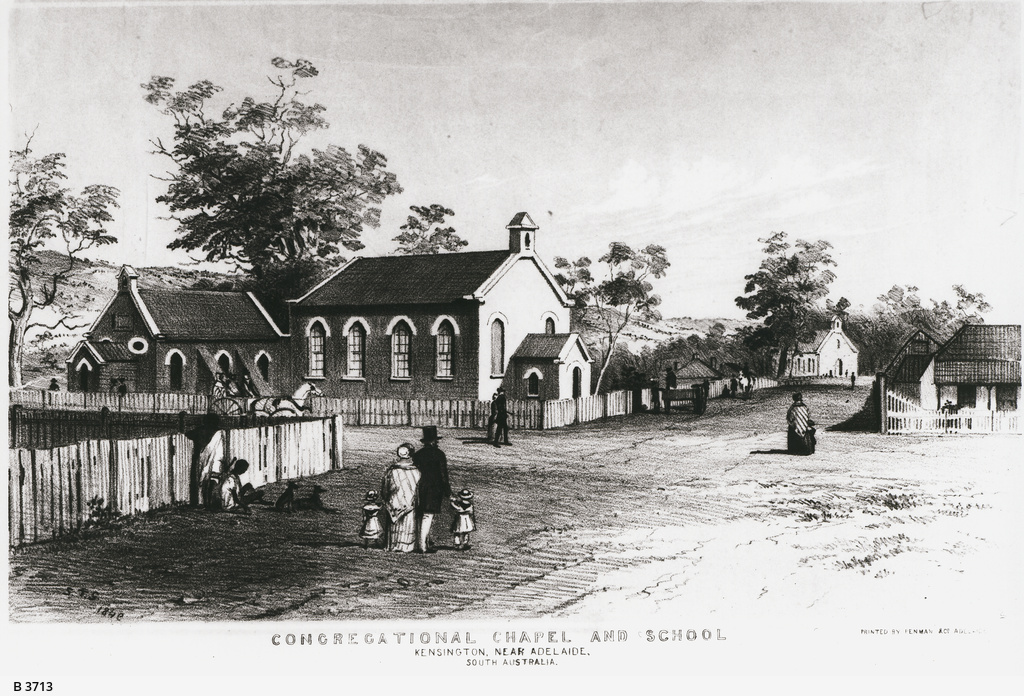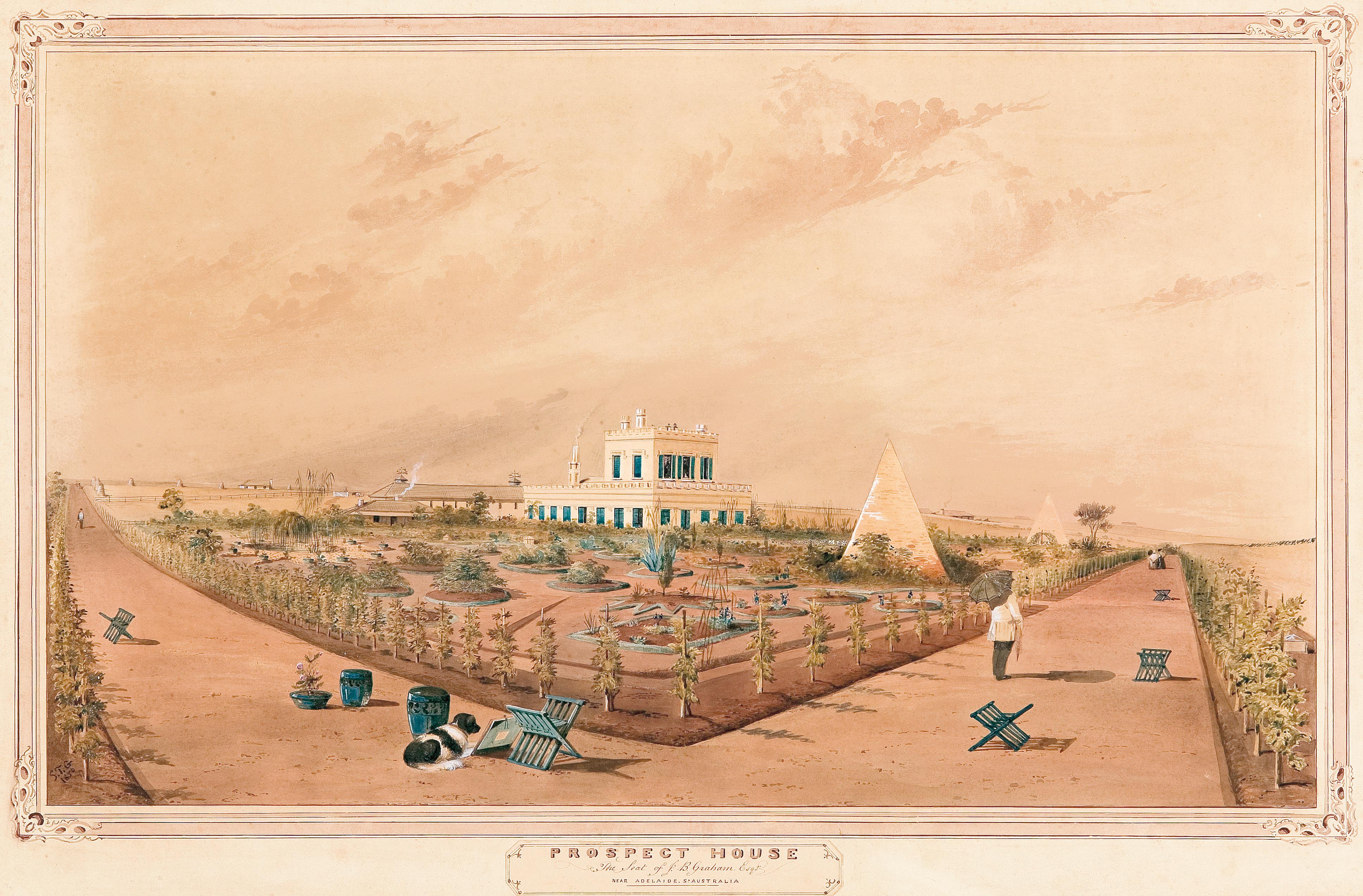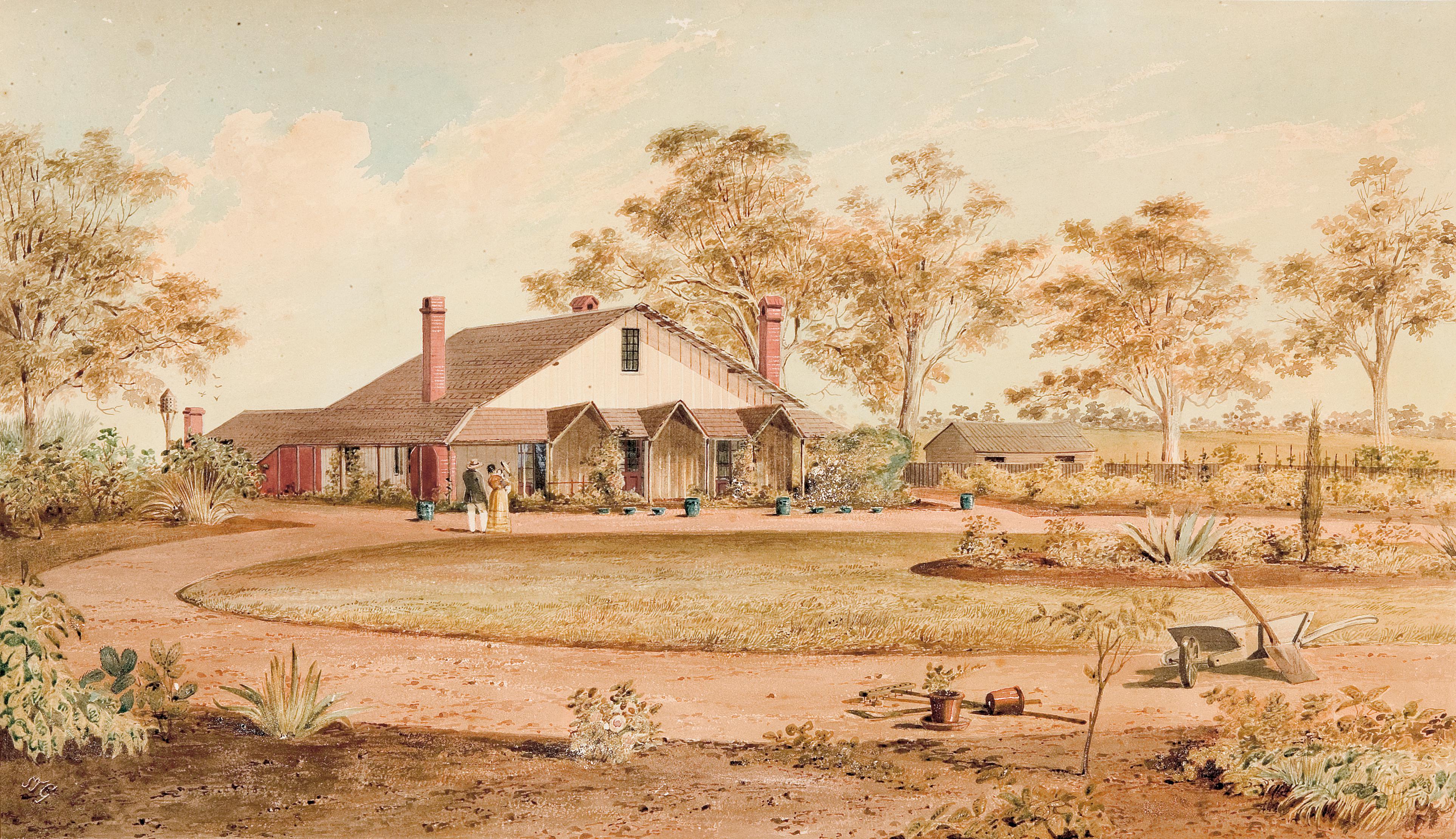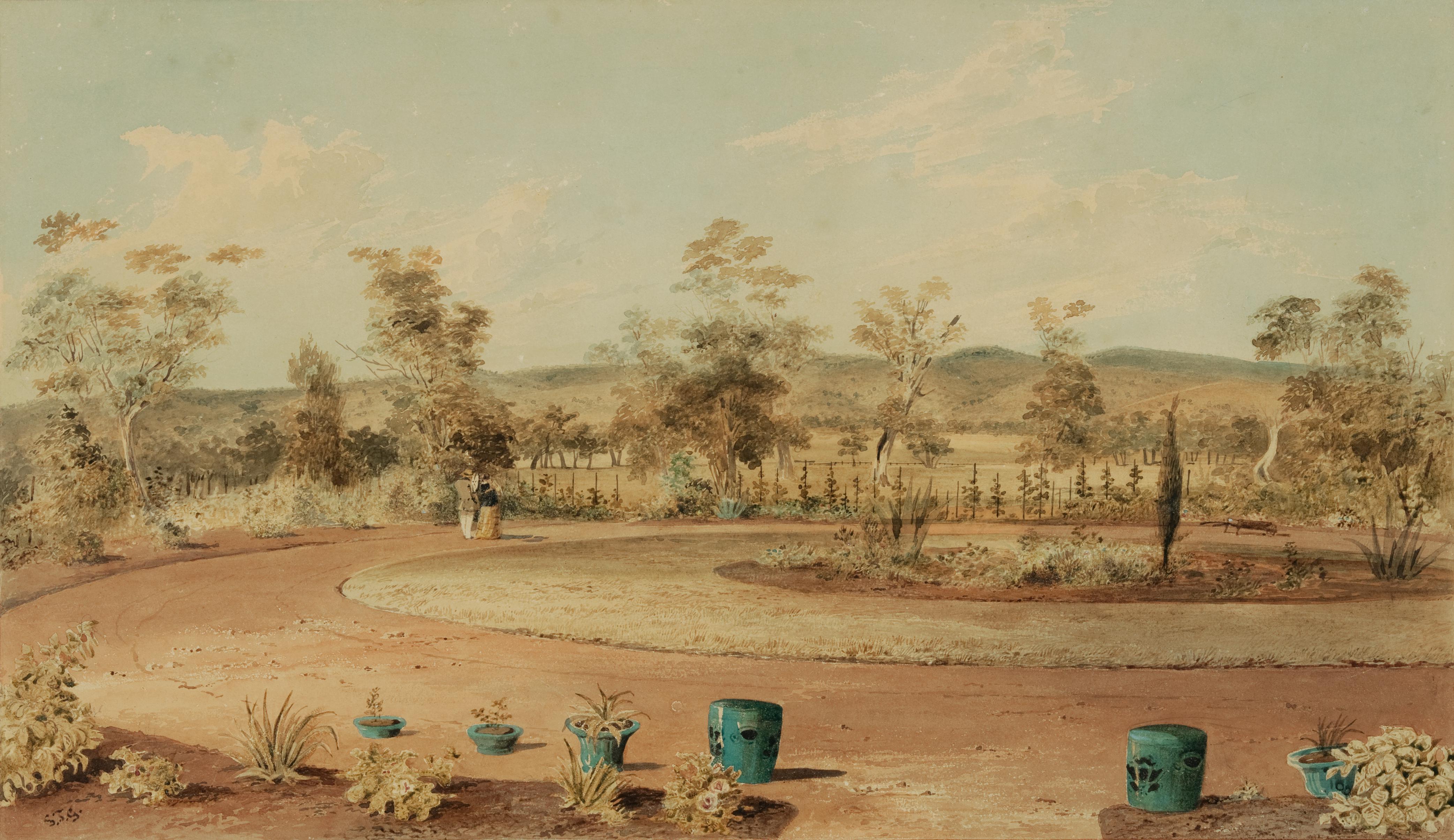
SUMMARY:September 1849 to February 1850. Fetes and house paintings. Following success with the Heads of the People lithographs with Penman & Co., Gill embraced lithography and its larger market, whilst continuing watercolours for clients.
Article type: NARRATIVE & CATALOGUE
In this article ...
Gill's lithographs with Penman & Co. – Heads of the People – had been quite a success. The final and third series was released at the end of August 1849. Gill then sought new lithograph opportunities in the form of souvenirs of well-attended public events.
The Adelaide Grand Steeple Chase was held on 18 September.
The day ... was as favorable for the sport as could have been desired. There was scarce any sun, but warm, dry, and no wind, all tending to the comfort, both of the riders and company. There were a great many people assembled, consisting of almost all the leading gentry and tradespeople of Adelaide and the neighbourhood, and some few of the fair sex also graced the course, both in carriages and horseback.1
Gill probably went and sketched. But, although no works can be tied to this specific event, Gill did paint several horse portraits around this time, especially of steeple chasers.
At the time Gill was working on another lithograph for popular reception – his first of two church fete prints that year. With an eye to the market, the artist and the printers saw to it that the lithograph would be mentioned in the press and available on the day.
We are requested to inform those of our readers who may not have seen the advertisement, that the Bazaar in furtherance of the Congregational Chapel at Kensington, will be held on Tuesday and Wednesday next. The proceeds will be applied for erecting the pews. Mr Gill the artist has furnished a clever and interesting sketch of the Chapel and School-house, with the church, part of the village, and the wooded hills in the background. The sketch is about to be lithographed, and those colonists who would gladly give their friends in Britain a correct idea of a much-admired South Australian village, will do well to attend the Bazaar, where copies of the drawing will be obtainable at a moderate price.2
The lithograph also included in the background the Episcopal (Anglican) Church of St. Matthew's (Kensington now Marryatville).3
Lithography with Penman & Co. – with Gill himself sketching on the stone – was becoming a major part of Gill's artistic output and presumably income.
While consolidating his new broader market with lithographs, Gill at the same time continued watercolours for clients with deeper pockets.
One such client were the drapers Brewer and Robertson. In October 1849 their new (and to be short-lived) business gave name to an enduring Adelaide landmark.
NEW DRAPERY ESTABLISHMENT.
THE BEE HIVE,
CORNER OF KING WILLIAM AND RUNDLE-STREETS.
Messrs. Brewer and Robertson BEG most respectfully to inform the inhabitants of Adelaide and South Australia, generally, that they will open the above premises on Tuesday next (to-morrow) October 2nd, with an entirely new and well selected stock of linen drapery, delaines, prints, calicoes, shawls, damasks, hosiery, fancy handkerchiefs, oil table covers, &c.,
&c., also, an immense lot of slop goods of every description; cloth caps, cabbage-tree and Java hats, stockmen's boots, and every article in wearing apparel suitable to this colony.4
The new shop was in the corner building James Allen built for his South Australian Register newspaper. Gill previously painted it for Allen in 1845. This time he painted it – likely for the new occupiers, Brewer and Robertson – in the last few months of 1849.
At the end of the year Adelaide expected another event crowd. On 20 December 1849 a fete was held in the grounds of J.B. Graham's Prospect House to celebrate the consecration of Christ Church, North Adelaide. Given there were 300 for lunch and as many children, Gill would have hoped for a profitable market for another lithograph with Penman & Co. Unlike the Kensington fete when he had the print for sale on the day, this time he captured the movement and colour of the fete itself.
FETE AT PROSPECT HOUSE.–We have been favored by Mr S. T. Gill, artist, with a very neatly executed lithographic print of the Fete, on the Consecration of Christ Church, given by John Adams, Esq., at Prospect House. It makes a very pleasing picture, and in every respect is a most creditable production.5
In the foreground of the scene the artist's portfolio leans against a folding seat – the artist is open for business.
Possibly on the strength of the fete lithograph, Gill was commissioned to further paint sets of watercolours of Prospect House and gardens for absent owner J.B. Graham as well as Vale Farm (see below) for Montague Phillipson. Both clients were mining money.
It would appear the collaborations between Gill and Penman & Co. were profitable for both parties.
A year after Penman & Co. began, the partnership was restyled as Penman & Galbraith – as a result of the early departure of James Campbell – and moved from Peacock's buildings (acre 75) in Hindley Street.
PENMAN & GALBRAITH, Lithographers and Copperplate Printers, RESPECTFULLY announce that they have removed from Peacock's buildings to Grenfell-street, corner of King William-street, where they will continue to carry on their business in all its branches. Maps, plans, drawings of machinery, architectural and landscape drawings, circulars, bills of lading, bills of exchange, bill heads, scrip, labels, business and visiting cards, &c., lithographed in every variety of style with neatness and dispatch.6
Gill would later team up again with Campbell in Melbourne.
The funeral on 6 February 1850 of Samuel Stocks, junior, a South Australian Mining Association (SAMA) trustee, director and orginal founder was perhaps a prompt for SAMA to ask Gill to update views of the Burra Burra Mine he'd originally done in 1847. A return to the Burra Burra mine was Gill's next major project.
To see these works, with accompanying notes, just scroll down or jump to the List of Works.
1. South Australian Gazette and Mining Journal, 20 September 1849: 2. <http://nla.gov.au/nla.news-article195938505>
2. South Australian Register, 22 September 1849: 2. <http://nla.gov.au/nla.news-article50246918>
3. South Australian Gazette and Mining Journal, 22 September 1849: 3. <http://nla.gov.au/nla.news-article195938528>
4. Adelaide Times, 1 October 1849: 1. <http://nla.gov.au/nla.news-article206981184>
5. South Australian, 25 December 1849: 3. <http://nla.gov.au/nla.news-article71625336>
6. South Australian, 8 February 1850: 3. <http://nla.gov.au/nla.news-article71625624>
You can scroll down to see all pictures along with detailed notes or click a link to jump to a specific work from the list.
 Fus-Buz, A Favorite Old Hunter: The Property of Mr J. Chambers, Adelaide 1849 | Private collection
Fus-Buz, A Favorite Old Hunter: The Property of Mr J. Chambers, Adelaide 1849 | Private collection
Artist: Gill, S.T. | Date: 1849 | Appleyard cat. 75
Catalogue: S.T. Gill, September 1849 to February 1850
"Fus-Buz" (a.k.a. "Fuzbuz") was a horse for the hunt / hounds belonging to James Chambers. Chambers was a horse dealer and ran stables and services for passengers and mail. In 1849 he was also the Clerk of the Course for horse races. Appleyard notes this is signed "Saml Thos Gill 1849".
244
 Congregational Chapel and School, Kensington | State Library of South Australia B 3713
Congregational Chapel and School, Kensington | State Library of South Australia B 3713
Artist: Gill, S.T. | Date: 1849-09 | Appleyard cat. n/a
Catalogue: S.T. Gill, September 1849 to February 1850
This scene was described as "the main street of Kensington, the more prominent objects in which are the Congregational Chapel and Episcopal Church." The lithographed print was to be available at the forthcoming chapel bazaar "at a moderate price". (South Australian Gazette and Mining Journal, 22 September 1849: 3. http://nla.gov.au/nla.news-article195938528)
At left of picture, the smaller church building is the first Congregational / Independent chapel at Kensington, opened in December 1844. "It is erected after the Gothic fashion; is 34 feet long by 20 feet wide; has a porch 10 feet by 12, and is surmounted by a cupola for a bell." (South Australian Register, 27 December 1844: 3. http://nla.gov.au/nla.news-article27448824). In 1848 it was insufficient for needs and a new building was begun adjacent. "The dimensions of the new chapel are 45 feet long by 30 wide in the clear. The old one adjoining will be set apart for a Sunday School." (South Australian, 7 April 1848: 3. http://nla.gov.au/nla.news-article71610942). It was opened in October 1848. This is the prominent building at centre of picture.
The road away from the viewer is Chapel Street (now an extension of Maesbury Street) and past the end of the street is the Episcopal (Anglican) Church of St. Matthew's (Kensington now Marryatville), the first service in which was conducted in October 1848. The cross street is High Street, making this a view generally to the south. In the background to the south-east are the "wooded hills". (In 1856 the feature chapel was referred to as Kensington Old Congregational Chapel (Rev. H. Cheetham's).)
"Printed by Penman & Co. Adelaide". In the process of drawing on the stone, Gill has accidentally left the fence showing through the body of the two wheel carriage.
Map | S. T. Gill - Adelaide District
173
St. John's Church | State Library of New South Wales PXC 284 18b
Artist: Gill, S.T. | Date: 1849 | Appleyard cat. n/a | 13(H) x 19(W) cm
Catalogue: S.T. Gill, September 1849 to February 1850
St. John's Church (acre 581) Halifax Street near East Terrace looking south-east with the hills in the background. The Governor's four-wheel carriage is at the front of the church. St. John's was opened for public worship with a service on Sunday 24 October 1841. Dated 1849 by Gill in the signature. For some reason - possibly aesthetic - Gill has shown five, not six, side windows in all his pictures of St John's. See Gill's NLA NK2038/25, NLA R110 (1845) and SLNSW PXC 284 18b (1849) and F.R. Nixon's six-windowed NLA S1161 (1845).
Map | S. T. Gill - Adelaide
259
 The Beehive, corner King William and Rundle Streets, Adelaide | State Library of South Australia B 60076
The Beehive, corner King William and Rundle Streets, Adelaide | State Library of South Australia B 60076
Artist: Gill, S.T. | Date: 1849-10/1849-12 | Appleyard cat. n/a
Catalogue: S.T. Gill, September 1849 to February 1850
The northeast corner of King William Street and Rundle Street (acre 46). Central in the picture is the newly launched "Bee Hive" drapery shop of Brewer and Robertson. The watercolour features an ornate scroll border by Gill.
Gill previously painted this corner in 1845 when this building was the recently vacated office of James Allen's "South Australian Register" newspaper (NLA NK2038/11 and AGSA 0.647).
Shop signs: Brewer and Robertson (The Bee Hive); along Rundle Street: Pearce, Tailor; Wigg; Selth; and along King William Street: Pace; Shadgett, saddler. A man plays a horn on the Port Adelaide spring cart which is about to depart - this is "Paddy's cornet".
Brewer and Robertson opened their drapery business in October 1849 but it only operated for seven months before they were taken over by J.V.B. Ryley (who retained the Beehive name). Gill dated this picture 1849, implying he painted it between October and December that year. It seems likely this picture was commissioned by Brewer and Robertson. It was displayed in the window of E.S. Wigg and Son in 1921.
E.S. Wigg, bookseller, binder, stationer, was here in Rundle Street at least from October 1849. R. M. Selth, Baker and Confectioner, operated here for years before selling out to James Jones around October 1850. John Henry Pace, watchmaker and jeweller, moved to King William Street in January 1849. Pace declared insolvency on 5 December. Newspapers indicate George Shadgett, saddler and harness maker, was in Rundle Street corner of Gawler Place, rather than King William Street.
Map | S. T. Gill - Adelaide
183
Fete at Prospect House, on occasion of the consecration of Christ Church, N. Adelaide, Dec. 20th 1849 | National Library of Australia S919
Artist: Gill, S.T. | Date: 1849-12 | Appleyard cat. 111 | 26.4(H) x 39.2(W) cm
Catalogue: S.T. Gill, September 1849 to February 1850
A view from the southeast showing a fete held in the grounds of Prospect House and marking the consecration of Christ Church, North Adelaide on 20 December 1849. The governor attended and it's likely his four-wheeled carriage which is seen at left.
Two distinctive garden pyramids are visible on the west side of the enclosed property. Behind them traffic runs on the Lower North Road. In the distance behind Prospect House is a substantial building with three chimneys on section 372. In the foreground is the artist's portfolio leaning against a folding seat - the artist is ready for business. Possibly on the strength of this picture, Gill was commissioned to further paint Prospect House and gardens for absent owner J.B. Graham.
Below the title is the following: "This print is respectfully dedicated to the Very Revd. the Lord Bishop and Clergy of So. Australia by their obedient and humble servant, Saml. Thos. Gill."
The lithograph was "Printed by Penman & Co., Adelaide" and was reported on Christmas Day, five days after the fete. Given 300 sat down for lunch (as well as 300 to 400 children), Gill would have hoped for a profitable market for this work.
Map | S. T. Gill - Prospect House
329
 Prospect House, the seat of J.B. Graham, Esqr., near Adelaide, South Australia | Art Gallery of South Australia 0.1348
Prospect House, the seat of J.B. Graham, Esqr., near Adelaide, South Australia | Art Gallery of South Australia 0.1348
Artist: Gill, S.T. | Date: 1850 | Appleyard cat. 106 | 40.7(H) x 68.3(W) cm
Catalogue: S.T. Gill and Prospect House
A view of Prospect House and property from the northwest. The landscaped gardens are featured with their two pyramids. Gill has added his personal presence by having in the foreground his Newfoundland dog (with collar) and artist portfolio leaning against a folding seat - the objects being the same as in the lithograph "Fete at Prospect House". Haystacks are in the background. Blue Chinese ceramic garden seats appear in both Vale Farm pictures as well as in two Prospect House watercolours.
Signed: "STG 1850".
Map | S. T. Gill - Prospect House
156
 Vale Farm | Art Gallery of South Australia 0.854
Vale Farm | Art Gallery of South Australia 0.854
Artist: Gill, S.T. | Date: 1850~ | Appleyard cat. 104
Catalogue: S.T. Gill, September 1849 to February 1850
Vale Farm, a Manning house, was the house of Jonas Moses Phillipson. He was a director of the Montacute Mining Company (as was E.L. Montefiore). This house was variously occupied by Phillipson and Levi families and E.C. Frome and is still standing (Auhl & Marfleet, 1977, p.35).
The work is inscribed on reverse: "M Philipson Esqr/ No. 1" (Appleyard), implying Gill's client was likely Jonas' brother Montague Levi Phillipson. This dates around 1850 and the subjects are almost certainly the Phillipsons with a child in arms. Blue Chinese ceramic garden seats appear in both Vale Farm pictures as well as in two Prospect House watercolours.
Map | S. T. Gill - Adelaide District
256
 From the Verandah of Vale Farm | Art Gallery of South Australia 0.855
From the Verandah of Vale Farm | Art Gallery of South Australia 0.855
Artist: Gill, S.T. | Date: 1850~ | Appleyard cat. 105
Catalogue: S.T. Gill, September 1849 to February 1850
View from the verandah of Phillipson's Vale Farm, looking ESE with the Mount Lofty Ranges in the background. Blue Chinese ceramic garden seats appear in both Vale Farm pictures as well as in two Prospect House watercolours. Inscribed on reverse: "M Philipson Esqr/ No. 2" (Appleyard).
Map | S. T. Gill - Adelaide District
257
Holmesdale, Adelaide | National Library of Australia NK469
Artist: Gill, S.T. (after) | Date: 1849~/1851~
Catalogue: S.T. Gill, September 1849 to February 1850
The original for this lithograph was by Gill. The scene is characteristic of him; most notably is the foreground arrangement of garden tools which is identical to Vale Farm (AGSA 0.854) and the two scenes are likely around 1850. The scene is of a suburban house (possibly a Manning house) and garden with a church next door.
"Holmesdale" isn't famous. The identity of the buildings is unknown. Around this time John William Holmes farmed at "Holmesdale" on Fourth Creek, but the scene seems more suburban that rural. There is also no apparent connection with Holmesdale, a later but obsolete suburb name which is now St. Morris.
The lithograph is inscribed "Hullmandel & Walton's New Process" suggesting this is an English production. What was the purpose of this lithograph - could it have been a real estate promotion? Is the scene real or imagined?
263
David Coombe, original October 2022, updated 17 October 2025. | text copyright (except where indicated)
CITE THIS: David Coombe, 2022-2025, S.T. Gill, September 1849 to February 1850, accessed dd mmm yyyy, <https://coombe.id.au/S_T_Gill/S_T_Gill_September_1849_to_February_1850.htm>